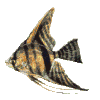The Kitsap
Aquarian Online
The Kitsap
Aquarian Online
|
|
Uromastyx acanthinurus The Sahara Desert region of Northwest Africa is home to one of the most unique reptile species: the Moroccan Spiny-tailed lizard. This mid-sized agamid is perhaps best known for its endearing personality along with spectacular and highly variable colours that are unequalled in the reptile world. Uromastyx lives in arid and semi-arid regions, ranging from stone deserts in the Sahara to dry scrub near the Southern Atlas Mountains. In all cases, the climate is extreme, with summer air temperatures well above 100F, while during the winter; temperatures may plunge well below the freezing mark. Rainfall is sparse, and Uromastyx has been found in areas that lack any precipitation for several consecutive years. Though this species is solitary in nature, it is often found in-groups or communities of 100 or mare. Each specimen occupies a discrete territory that is centered on a relatively large burrow (up to 18 feet in length) that is used as a retreat from predators or extreme heat, as a place to sleep and hibernate and as a site for egg deposition. Uromastyx are inactive during the winter months, but are constantly active during the daylight hours of the summer. Uromastyx is omnivorous feeding on both plants and insects. A spectacular and highly variable repertoire of colour schemes sets Uromastyx acanthinurus apart from other species. Ground colour range from fluorescent orange, yellow, and green or red to rust-brown or black speckling that can be irregular or patterned to form ocelli or bands. The underside is white or cream, sometimes with black speckling. Colour is genetic. Young usually inherit the colours from both parents. Colour also seems to be sex linked; for example, male offspring tend to inherit the colour of the father, with a similar case for female offspring. However, it should be stressed that unlike other Uromastyx species, colour is not sexually dimorphic in U. acanthinurus. All in all, due to its size, docility and fantastic colours, U. acanthinurus is a wonderful addition to any reptile collection.
|
|